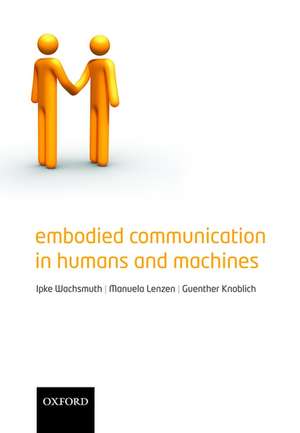Embodied Communication in Humans and Machines
Editat de Ipke Wachsmuth, Manuela Lenzen, Günther Knoblichen Limba Engleză Hardback – 4 sep 2008
Preț: 782.70 lei
Preț vechi: 1179.39 lei
-34% Nou
Puncte Express: 1174
Preț estimativ în valută:
149.79€ • 155.80$ • 123.66£
149.79€ • 155.80$ • 123.66£
Carte tipărită la comandă
Livrare economică 03-09 aprilie
Preluare comenzi: 021 569.72.76
Specificații
ISBN-13: 9780199231751
ISBN-10: 0199231753
Pagini: 496
Ilustrații: 59 line figures; 46 black and white photos; 1 colour plate
Dimensiuni: 180 x 255 x 35 mm
Greutate: 1.02 kg
Editura: OUP OXFORD
Colecția OUP Oxford
Locul publicării:Oxford, United Kingdom
ISBN-10: 0199231753
Pagini: 496
Ilustrații: 59 line figures; 46 black and white photos; 1 colour plate
Dimensiuni: 180 x 255 x 35 mm
Greutate: 1.02 kg
Editura: OUP OXFORD
Colecția OUP Oxford
Locul publicării:Oxford, United Kingdom
Notă biografică
Ipke Wachsmuth is director of the Center for Interdisciplinary Research (ZiF) and Chair of Artificial Intelligence at the University of Bielefeld. He holds a Mathematics Master's degree and a Ph.D. both from the University of Hannover and an Informatics Habilitation degree from the University of Osnabrück. Before coming to Bielefeld, in 1989, he held faculty and project leader positions in the Department of Mathematics/Computer Science and the Linguistics Department at the University of Osnabrück. He was also assistant professor in the Department of Mathematical Sciences at Northern Illinois University in 1981-83 and research fellow at IBM Germany in 1986-88. Ipke Wachsmuth is a former president of the German Cognitive Science Society and has a strong multidisciplinary commitment, reflected in many research papers published in areas related to the understanding and modeling of human behavior as well as the exploitation thereof in intelligent systems.Manuela Lenzen did her Ph D in Philosophy 2002 at the University of Bielefeld and works as a science writer, free lance journalist and translator. Since 2005 she has been Managing Assistant to the Research Group Embodied Communication in Humans and Machines, ZiF, Bielefeld, GermanyGünther Knoblich is currently Professor of Social Cognitive Neuroscience at the University of Birmingham. He received his PhD from the University of Hamburg in 1997. From 1997 to 2004 he was a research scientist in the Cognition and Action group of the Max Planck Institute for Psychological Research. From 2004 to 2007 he was Associate Professor of Psychology at Rutgers University. In 2005 he received the American Psychological Association's (APA) Award for Distinguished Early Career Contribution to Psychology. He is Associate Editor of the journal Social Neuroscience. His research interests include body perception and action perception, the sense of agency, and joint action.










